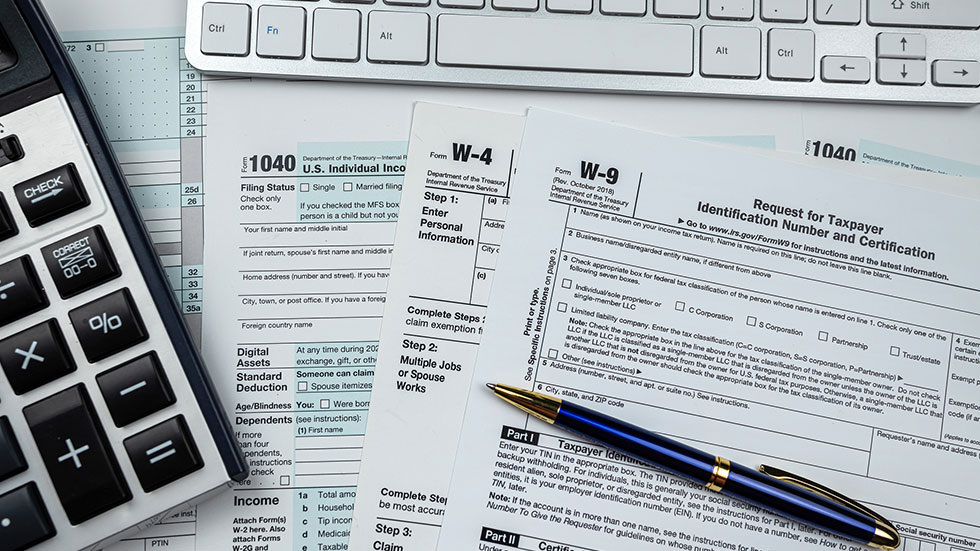Tax Filing 101: 7 Things That Can Impact Your Tax Refund
Get the most accurate tax refund possible by following these simple tips

Sponsored Content
It’s time to review some important tax basics before the upcoming tax season. Here are seven things to keep in mind when e-filing your federal income tax return this year — and how each could impact your refund amount.

1. Life events
Before you begin filling out your federal return, you will be asked basic questions about your marital status, whether you have kids, or if you had any significant life events happen this tax year.
One of the best things you can do to get an accurate refund estimate is to fill out your Basic Info before you start inputting any of your tax forms.
While it might be tempting to skip this step and jump right into your W-2s and other income, not so fast! Your answers to the Basic Info questions help us guide you to which tax credits and deductions you might qualify for later.
Entering your basic information upfront will ensure we are factoring in the tax breaks you could potentially claim. This not only makes the tax filing process as simple and straightforward for you as possible, but it could potentially save you money as well.
2. Filing status
After you fill out your basic information, tax software suggests which tax filing status might be best for you.
There are five options you can choose from:
- Married filing jointly
- Married filing separately
- Head of household
- Single
- Qualifying surviving spouse (QSS)
Sometimes you might qualify for more than one filing status. In this case, suggestions for filing status will likely be provided to give you the most tax advantages. Handy, right?
This is another reason why filling out your Basic Info first is essential to get the most accurate approximation of your tax refund!

3. Dependents
As you’re filling out the Basic Info section, you will also be asked if you have any dependents to claim.
A dependent is anyone who relies on someone besides themselves (or their spouse) for financial support. Typically, a dependent would be either your qualifying child or another relative. You cannot claim your spouse as a dependent.
Here are the basics of who can qualify as a dependent:
- Your qualifying child under 19 years old (or under 24 years old if they are a full-time student)
- Your child of any age if they are permanently or totally disabled
- Another qualifying relative (stepchild, sibling, parent, etc.)
The dependent also may not:
- Provide more than half of their own financial support
- File a joint return with a spouse
Claiming dependents on your tax return can open the door to many tax benefits. If you list dependents in your Basic Info section, you may qualify for certain tax deductions and credits, which you will be guided to identify later.
For example, let’s say you are married with two kids who qualify as dependents. This means you likely qualify for the Child Tax Credit, which will be suggested to you in the Credits section of your federal tax return.
Now let’s assume your kids are in daycare while you and your spouse work during the week. If so, you may qualify to claim the Child and Dependent Care Credit, worth 25-35% of qualified childcare expenses you may have paid. You can receive a maximum credit of up to $2,100 on up to $6,000 for two or more qualifying dependents. So, if you list dependents in your Basic Info, you will be asked about childcare costs.
These are just two examples of how claiming dependents could increase your tax refund, but you could also qualify for other child-related tax breaks.

4. Tax deductions and credits
Tax deductions and tax credits are two distinctive things.
Both tax deductions and tax credits can reduce the amount of taxes you pay — but they do so differently.
A tax credit allows you to subtract the credit amount from your taxes owed as a dollar-for-dollar tax reduction. For example, if you owe $3,000 in taxes and receive a $2,000 tax credit, your tax bill would decrease to $1,000.
Some tax credits are refundable. This means that if the tax credit reduces your tax bill below zero, you get the excess credit amount refunded. For example, if you only owe $2,000 in taxes and receive a $4,000 refundable tax credit, you will receive the excess $2,000 as a tax refund.
A tax deduction, in contrast, reduces your taxable income instead of your taxes owed. For instance, if your taxable income was $50,000 and you received a $5,000 tax deduction, your taxable income would decrease to $45,000.
Both credits and deductions contribute to your total refund amount. Just make sure you answer all questions when e-filing so we can help you identify which tax breaks you could claim!

5. AGI
While filling out your income tax return, you may see “AGI” referenced. What does this mean?
AGI stands for adjusted gross income. Your AGI is your gross income (wages, business income, capital gains, etc.) minus certain deductions (retirement contributions, student loan interest paid, and HSA contributions, to name a few).
AGI is not the same as your taxable income; instead, your AGI helps determine your taxable income. AGI minus the standard deduction ($13,850 for a single filer in 2023) and any other above-the-line deductions you qualify to claim is your taxable income.
6. Standard deductions vs. itemized deductions
Now that you know what tax deductions are, let’s look at the two deduction options you have when filing your income tax return.
First up: the standard deduction.
The U.S. tax system allows every taxpayer to receive a standard deduction. This is a flat dollar amount that everyone can automatically subtract from their taxable income.
Your standard deduction amount depends on the tax filing status we mentioned earlier. For tax year 2023, the standard deduction is $13,850 for single taxpayers. Standard deduction amounts typically increase every year to account for inflation.
But you don’t have to take the standard deduction — there’s also another option called itemized deductions.
When you itemize, instead of taking the standard flat-rate deduction, you’d list all your deductions separately. Some examples of itemized deductions are personal property taxes, some medical expenses, disaster losses, and any state sales tax or state income tax you paid.
It typically only makes sense to itemize if the total of your itemized deductions exceeds the standard deduction. This generally means you’ll owe less federal income tax, which can increase your tax refund.
For example, let’s say you add up all your itemized deductions as a single filer for 2023, and the total is $9,000. You would probably want to claim the standard deduction instead, which would be worth $13,850 — over $4,000 more.

7. Your tax refund
And finally, the one you’ve been waiting for — your tax refund!
If you had excess income tax withheld from your paychecks during the year, you could get it back as a tax refund when you file your return. You may also be able to claim a tax refund if you qualify to claim enough refundable tax credits.
When you file electronically, you can choose how you’d like to receive your tax refund. How long it takes to get a tax refund varies from person to person. The quickest way to receive your refund is to e-file your return and choose to have your refund directly deposited into your bank account.
You can also check the status of your refund. The IRS has a tool called Where’s My Refund? that allows you to track your tax refund 24 hours after e-filing your federal return. The IRS updates this tool daily, typically overnight.
If you’d rather use a mobile device, you can track your refund using the IRS2Go app.
Some tax returns take longer to process than others — it depends on whether your return needs corrections or includes certain forms. You can call the IRS for an update if you haven’t received your refund within 21 days of e-filing (or six months with paper returns).
This article is for informational purposes only and not legal or financial advice. All TaxAct offers, products and services are subject to applicable terms and conditions.
